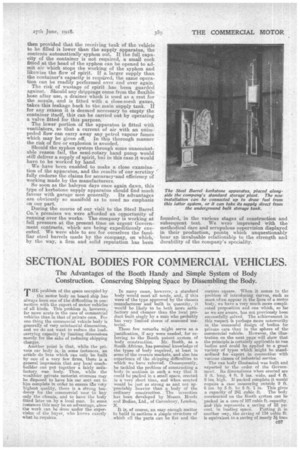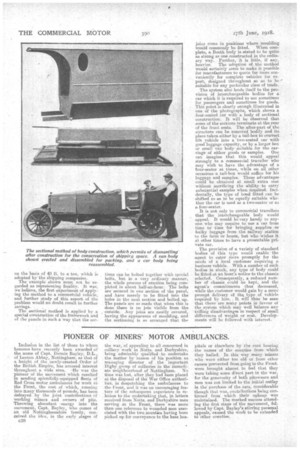SECTIONAL BODIES FOR COMMERCIAL VEHICLES.
Page 15

Page 16

If you've noticed an error in this article please click here to report it so we can fix it.
The Advantages of the Booth Handy and Simple System of Body Construction. Conserving Shipping Space by Dissembling the Body.
THE problem of the space occupied by the motor body on hoard ship has always been one of the difficulties in connection with the export of motor vehicles of all kinds. This problem is, however, far more acute in the case of commercial vehicles than in that of private cars. For one thing the commercial vehicle body is generally of very substantial dimensions, and we do not want to reduce the load. carrying capacity by limiting dimensions merely for the sake of reducing shipping charges. • Another point is that, while the private car body is, in some instances, an article de luxe which can only be built, by one of a very few firms' there is a general impression that any local coachbuilder can put together a fairly satisfactory -van body. Thus, while the -wealthier private motorist overseas may be disposed to have his car sent out to him complete in order to ensure tile vety highest quality, There is a strong tendency for the commercial user to buy only the chassis, and to have the body fitted later on by a local man. In some instances this may be an advantage, since the work can be done under the super, vision of the buyer, who knows exactly what he requires. , In many eases however, a standard body would meet; all -needs, and, if this were of the type approved by the chassis manufacturer andbuilt in quantity, it would be likely to be both more satisfactory and cheaper than the local product built singly by a mart who probably has very limited stores of seasoned material.
These few remarks might serve as a justification, if any were needed, for referring to the Booth patent system of body construction. Mr. Booth, as a South African, has personal knowledge of the types of body required, at least in someof tho oversea =Acts, and also has experience of the shipping difficulties to which we have referred. Consequently, he tackled the problem of constructing a body in sections in such a way that it could he packed in a small space, erected
a -very short time, and when -erected would be just as strong as and net ap"preciably heavier than a body of the ordinary construction. , The invention has been developed by Messrs. Hoods and Bodies, Ltd., of Can onbury, London, N.
It is, of course, an easy enough matter to build in sections a simple -structure of which all the parts can be flat and the
corners -square. When it comes to the problem of introducing curves, such as must often appear in the Lines of a motor body, we have a very much more complifated proposition and one which, so far as we-are aware, has not previously been successfully solved. The achievement in this respect is perhaps snore noteworthy in the successful design of bodies for private cars than in the sphere of the commercial vehicle. . However, the illustration on the next .page will show that the principle is certainly applicable to van bodies and could be applied to a groat variety of types which might be standardized for export in connection with various classes of industrial service.
The van body illusteated was built and experted to the order of the Government. Its dimensinons when erected are 9 ft. long, 4 ft. 8 ins, wide, and 4 ft. 9 ins. high. If packed complete it would require a case measuring outside 9 ft. 6 ins by 5 ft. by 5 ft. 1 in. This gives a capacity of 241 cubic ft. The body constructed on the Booth system ca-n be packed M. a case of 107 cubic ft.-capacity, andt this represents a saving of 55 pez cent. in loading spaea-. Putting it in another way, the saving of 134 cubic ft. is equivalent to a saving of nearly 3i tons ea7
an the basis of 40 it: to a ton, whieli is adopted by the ,shipping companies. The example shown mat not be regarded as repreienting finality. It was we believe, the first experiment of applying the Method to a commercial vehicle, and further study of this aspeot, of the problem would no doubt result in further savings. .
The sectional method is applied by .a special construction of the framework and of the panels in Such a 'way that the sec tions can be bolted together with special bolts, but in a very ordinaiy manner, the whole process of erection being completed in about half-an-hour. The bolts are secured in one section of the panel, and have merely to be fitted into the holes in the next section and bolted up. The panels are so made that when this is done there is no join visible from the , outside. Any joins are neatly covered, having the appearance of moulding, and the sectioning is so arranged that the joins come in positions where moulding would commonly be fitted. When complete, a Booth body is stated to be quite as strong as one constructed in the ordinary way. Further, it is little, if any. heavier. The adoption of the method would certainly seem to make it possible for manufacturers to quote far more conveniently for complete vehicles for export, designed throughout so as to be suitable for any particular class of trade.
The system also lends itself to the provision of interchangeable bodies for a car which it is required to use sometimes for passengers and sometimes for goods. This point is clearly enough illustrated in one of the photographs, which shows a four-seated car with a body of sectional construction. It will be observed that some of the sections terminate at the rear of the front seats. The after-part of the structure can be removed bodily and. its place taken either by a tail-box to convert th‘e vehicle into a two-seated car with good luggage capacity, or by a larger box or small van body suitable for the car rings • of either goods or samples. One can imagine that this would appeal strongly to a commercial traveller who may wish to have the advantage of a 'four-seater at times, while on all other occasions a tail-box would suffice for his luggage, and samples. These advantages could be obtained at small extra cost without sacrificing the ability to carry substantial samples when. required. Incidentally, the type of hood fitted can be shifted so as to be equally suitable whether the car is used as a two-seater or as a four-seater.
It is not only to commercial travellers that the interchangeable body would appeal. It would be very handy to anyone who may require to use a car from time to time for bringing supplies -or bulky luggage from the railway station to the farm or houge, but who wishes it at other times to have a presentable private car.
. The provision of a variety of standard bodies of this type would enable the agent to cater more promptly for the needs of a local customer requiring a. business vehicle. With a number of such bodies in stoek, any type of body could be .fitted at an hourf's notice to the chassis selected.. Consequently, a reduced number of chassis could be kept, and the agent's commitments thus decreased, while the customer would gain by a more prompt delivery of the type ef 'vehicle required by him. It will thus be seen that there are many points in favour of ,. the system which may well balance any trifling disadvantages in respect of small differences of weight or cost. Developments will be followed with interest. •






















